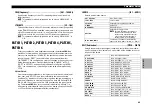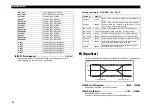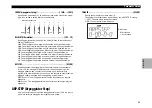
microKORG XL+
38
1. When Wave: Saw, Pulse, Triangle, Sine and OSC1 Mod: Waveform
Control1: WAVEFORM............................................................[000…127]
This modifies the waveform.
•
WAVE: SAW
000
063
127
The sawtooth wave is appropriate for creating a wide range of sounds typi-
cal of analog synthesizers, including basses and pads. Adjusting the value
will modify the shape of the waveform, changing the harmonic content. A
setting of 000 produces the original sawtooth wave. Higher setting stress
different harmonics; a setting of 127 produces a sawtooth wave one octave
higher.
•
WAVE: PULSE
000
063
127
This is a pulse wave suitable for electronic sounds and wind instruments.
By adjusting the pulse width you can produce sounds reminiscent of a clavi
or sax. A setting of 000 produces a simple square wave. Higher settings
narrow the pulse width, and at a setting of 127, the pulse width will disap-
pear completely (no sound).
•
WAVE: TRIANGLE
000
063
127
Triangle waves have fewer overtones than sawtooth or square waves, and
they’re suitable for mild tone such as bass or pads. Adjusting the value will
modify the shape of the waveform, changing the harmonic content. A set-
ting of 000 produces a simple triangle wave. Higher setting stress different
harmonics; a setting of 127 produces a triangle wave that is one octave and
a fifth higher (i.e., the third harmonic).
• WAVE: SINE
000
063
127
Sine wave is a mild tone that contains only the fundamental frequency with
no overtones. A setting of 000 produces a simple sine wave. Increasing this
value will modify the waveform, changing the overtone structure as shown
below.
Control2: LFO1 Intensity ...................................................... [000…127]
LFO1 will vary the “OSC1.C1” effect (Waveform Modulation.) “OSC1.C2”
adjusts the depth of this change.
If the LFO1 “WAVE” (
p. 47 “LFO 1, LFO 2”) is set to TRIANGLE, this will
produce a detune-like effect for a sawtooth wave (“WAVE”: SAW). For a
pulse wave (“WAVE”: PULSE), it will produce a PWM (Pulse Width Modula-
tion) effect, making the sound thicker.
2. When Wave: Formant and OSC1 Mod: Waveform
Control1: FORMANT WIDTH................................................... [000…127]
The formant waveform has a tonal character reminiscent of a human voice.
This knob will adjust the frequency components that are characteristic of
vocal formants. This is similar to the way vowel sounds change depending
on the shape of your mouth.
Control2: FORMANT SHIFT ................................................... [–63…+63]
This moves the entire formant frequency spectrum upward or downward.
With a setting of 0, the formant locations are unchanged.














































